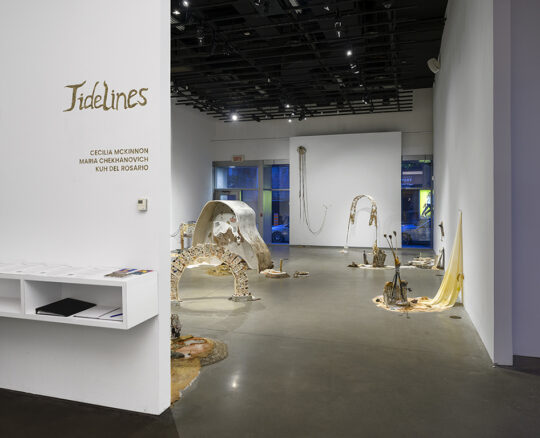
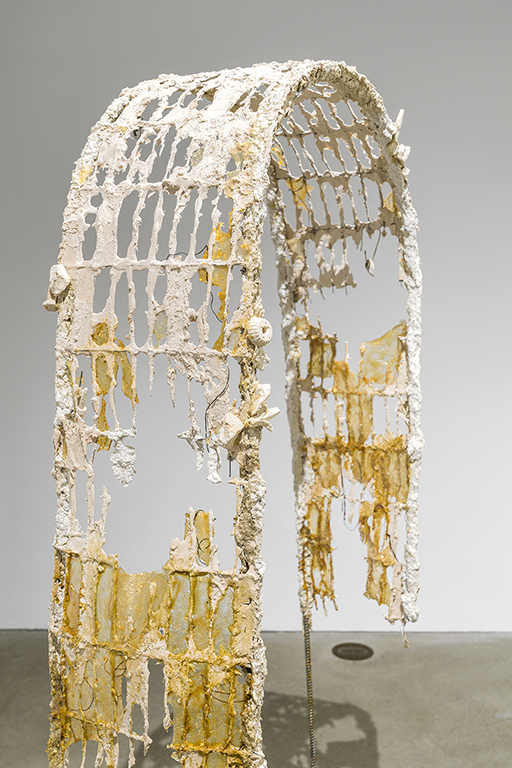
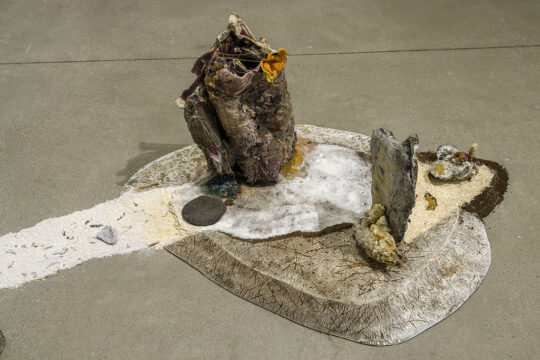
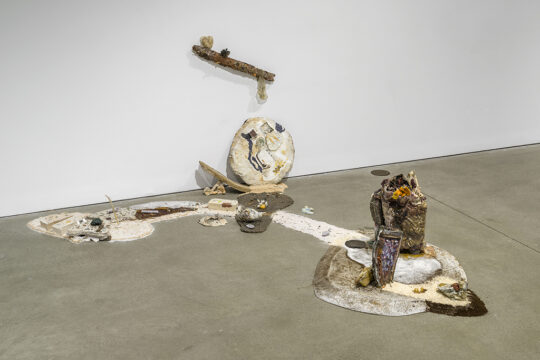
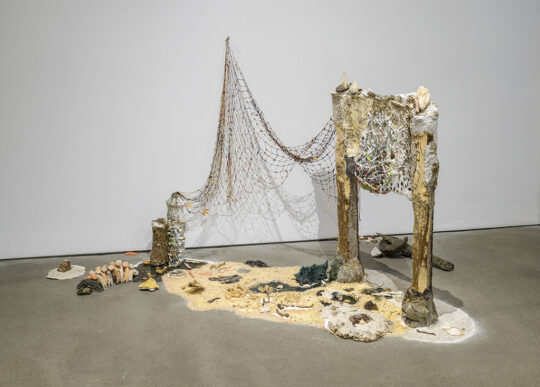
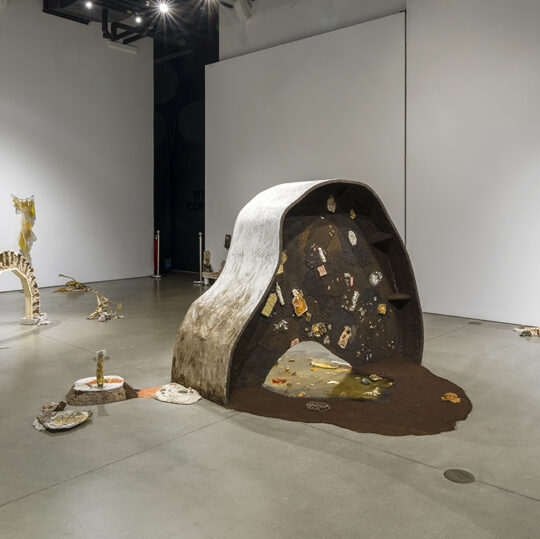

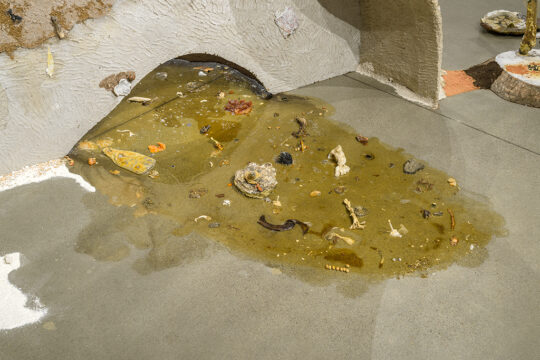
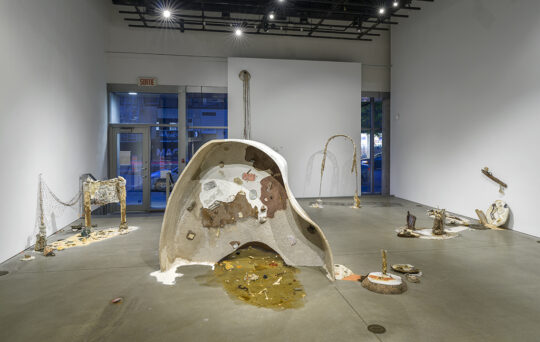
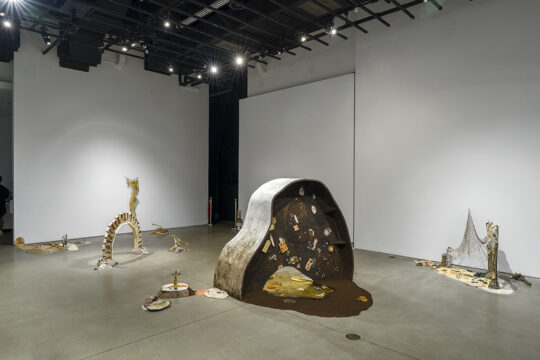
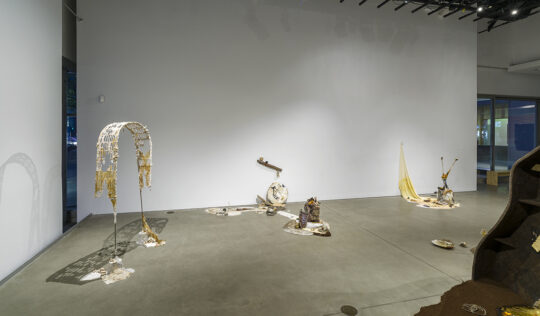
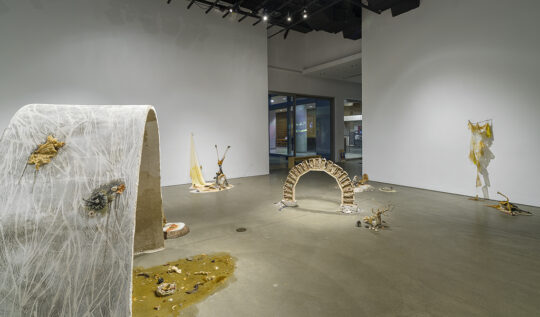
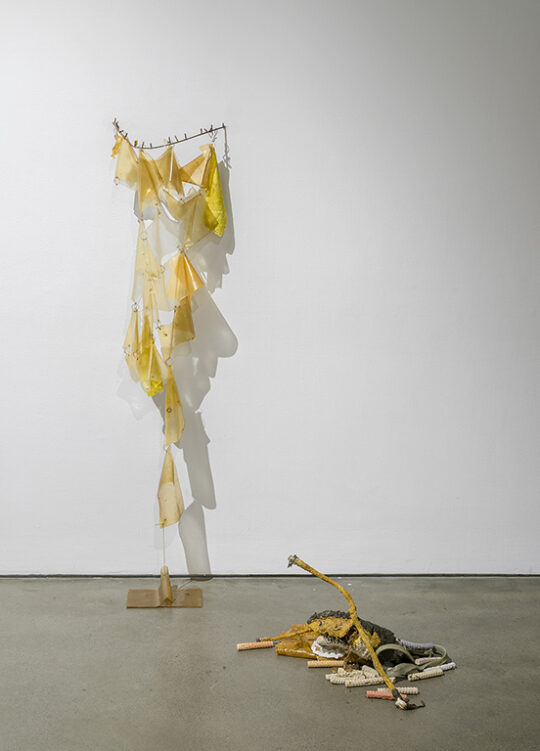
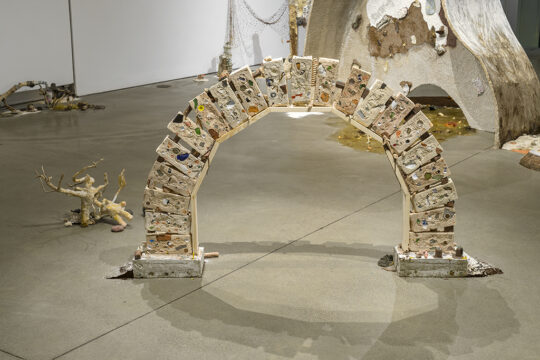
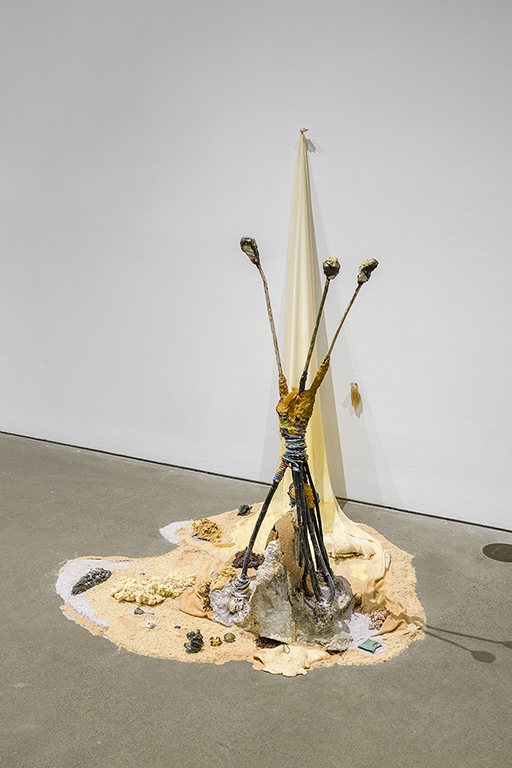
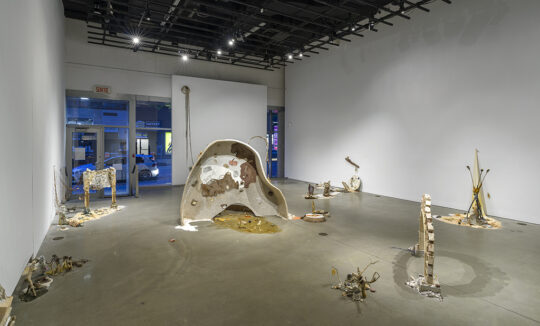
TIDELINES /
Lignes de marée
group EXHIBITION W/ MiriA Chekhanovich & Cecilia McKinnon
FOFA GALLERY
1515 St. Catherine O, Room EV 1715
Montreal, Quebec H3G 1S6
Vernissage: THURSDAY, MAY 2, 2024 at 5:00 pm
Exhibition Run: MAY 2 – JUNE 7, 2024
—————————————————————————————-
Tidelines brings together the work of Miri Chekhanovich, Kuh Del Rosario, Cecilia McKinnon in a collaborative sculptural installation. This project is born from a desire to convene the three artists’ overlapping material vocabularies, to form a new language together in a shared space, and to initiate material processes which leak into one another in the time and space of the exhibition.
All three artists enact gestures of repetition in processing their materials: gathering, dehydrating, grinding, cooking, casting, and flocking. They perform the generative ‘natural’ processes of erosion and reconstitution in the compressed timescale of the studio. Kitchen compost, mineral remnants, household and studio waste, and ubiquitous ingredients cohere into durational sculptures which desiccate, crystallize, melt, or host new life. Materials are encountered as half-digested by entropy and circulation through the currents of everyday life and global economies.
—————————————————————————————-
Tidelines; Generous Entanglements
BY Geneviève Wallen
THE LAND- The air smelled like coffee
On Monday, April 22, 2024, I entered the gallery and was immediately greeted by an enveloping coffee smell. Ground coffee, collected over time by Kuh Del Rosario, blended with remnants from the Van Houtte across the hall, formed an outer rim surrounding the back side of a grotto-shaped structure under which a reflective pool of gelatin is yet to be poured. I strolled around full of excitement as I discovered the installation’s most recent additions: a small archway made of hollow hand-made bricks mounted with replicas of screws and hammerheads; eggshell grounds, sawdust, sea salt, and brightly coloured powders were delicately sprinkled on and around flat concrete disks.
The blueprint of a pathway, an archipelago in formation, was furrowing the floor. I could easily imagine future visitors meandering the network of archway portals. A makeshift laboratory had taken form in the reception area: cooking pots, mason jars, and
containers were filled with wax, agar, glycerin, glue, vitamin C, and spices, among other ingredients; wet and dyed paper pulp on a strainer hung above a bucket of water; a magic bullet full of pulverized eggshells. Each artist shared with glee the treasures they
brought with them; here, what is considered precious is entangled with notions of transience and permanence: a crushed can, an orange peel, rocks, driftwood, seashore polished glass, church candles, hand-dyed silk curtains, and repurposed bioplastic
sheets. It was evident that the intrinsic value of these items lay in the artists’ intimate connection with the material, the time spent gathering and transforming them, and their grounding presence in their pockets or in the studio space. Drifting disposable objects
have found a renewed value and purpose while in the artists’ care. As they unpacked the worlds they carefully transported in bins, cardboard boxes, and suitcases, what is unfolding in the gallery space is a fragile balance between controlled and improvised movements described by Cecilia McKinnon as “call and response between our impulses and between emerging moments in the installation.” 1 The gallery’s in-situ archipelago became a meditation on relationship building and trust. Maria (Miri) Chekhanovich explained that “(…) an improvised process and deep trust allowed [her] to have an interesting approach to the overall exhibition, where things were not fixated, there was always an element of surprise even in the arches and more “constructed” elements, there was a constant movement (…).” 2
This installation reintroduced questions about the porosity of the materials central to the artists’ respective practices. As their material converged and knowledge poured into one another; they became the sea.
THE WATER- Who made what?
Surrounded by their materials, Chekhanovich, Del Rosario, and McKinnon were brainstorming an installation to-do list. Sitting on the ground around an oversized piece of sketching paper held by small stones and found objects, they anchored themselves in the gallery space while delegating collective and individual tasks. The columns “Must” and “Can” constituted the framework from which they will materialize the world they were co-creating. Juxtaposing “Must”; and “Can” prompted them to consider what additional offerings they could extend to each other and the audience if time permitted. As I returned to the gallery on April 23 rd , I read under the column “Must” itemized actions with cryptic titles and initials:
– Curtain/Eyelers– M+C
– Back wall puddle- C+K
– Médusa – Strings bioplastic- M+C+K
– Paper Arch – Legs, bioplastic, pool reflective- C+M
The list went on with more instructions and codes belonging to their shared material investigations and common understanding of spatial division and labour. How does one answer the visitors’ question: who made what? Especially, when the artists have
intentionally blurred the lines of their respective practices. The audience was mesmerized by the playfulness and intricate encounter of textures in the installation, yet they remained puzzled about the question of authorship. Each decision was made in consensus and approached with curiosity: sometimes while they were sprinkling powder around the same island and other times stirring, melting, and grinding materials next to each other. McKinnon noted that: “[they] talked frequently about being ‘precious’ —
which can mean both being overprotective and fussy about the work or can also indicate a personal boundary around how an item should be cared for and handled.” 3
The necessity of working along the lines of clear-cut identifiers of authorship was unsettled. Del Rosario observed that “trusting Miri and Cecilia required me to trust in myself as well. Every time I decided to let go of control, I was also exercising my agency
within the space.” 4 As I witnessed their collaborative methodology, I contemplated the generosity inherent in their approach and how it challenged the expectation of the myth of the “genius artist.” Since the intention is to push the potential of collaboration as a
horizontally enmeshed process rather than co-habitation, I wondered what constitutes generous work. What can we borrow from the tides and tidelines as a foundation for relational ethics?
THE SHORE- Wonder is in the little details
A small group of young people came in. They saw a glimpse of the exhibition through the York Vitrines and claimed they had to visit. They pointed at the grotto and its busy gelatinous river; soft sounds of wonder can be heard. Aaaaah!
As they walked closer to a small protrusion hung high on the furthest wall with messy, drippy tentacles, I heard an Ooh!
They crouched to better see the works closer to the floor, and like previous visitors, they mentioned wanting to touch everything. Woaaah!
I observed passers-by on Sainte-Catherine Street stopping intrigued by a discreet water feature bubbling in a copper-coloured bucket surrounded by sparkling rocks, colourful nuts and bolts, and a cast wax hand. The arrangement of objects looked like a display of a beach bounty, inconspicuous palm-sized prizes. They formed sinuous lines along an imagined shore, tracing the final creative encounter of the artists, the last shoreline in the gallery space. I reminisced about a quiet Saturday afternoon when Chekhanovich, Del Rosario, and McKinnon added melted wax to the bucket, watched it form, and discussed divination rituals around wax reading. A protest in solidarity with Palestine passed through, and we were brought back to the present, to our world in erosion, to the heavy feelings individually and collectively harboured in the past several months in the wake of multiple accounts of extreme violence and ethnic cleansing happening at once – Congo, Armenia, Sudan, Haiti, and many others. The artists’ words are all the
more vivid; “Teach me how to cope with erosion, how to live alongside my mortality. Show me what emerges when the surface tears, what otherworld lies in wait. Tell me how to unknow the world at this edge of things.” 5
1 Cecilia McKinnon, email message to author, June 25, 2024.
2 Maria (Miri) Chekhanovich, email message to author, June 25, 2024.
3 Cecilia McKinnon, email message to author, June 25, 2024.
4 Kuh Del Rosario, email message to author, June 25, 2024
5 Collective writing, Cecilia McKinnon, Kuh Del Rosario, Maria (Miri) Chekhanovich, April 2024.